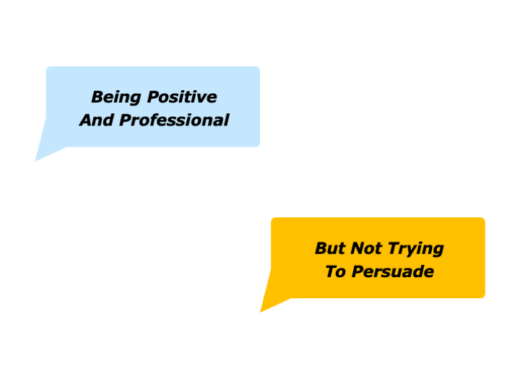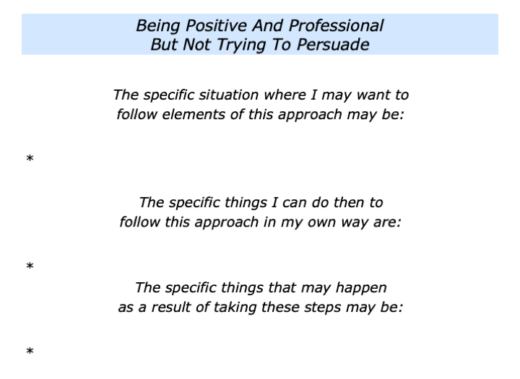
There are many ways to help people. This piece looks at one approach that I learned from some great psychotherapists. Many embodied the qualities demonstrated by superb educators.
They focused on inspiration, implementation and integration. They aimed to create an inspiring environment and provide implementation tools that worked. They then helped people to integrate the learning into their daily lives and work.
The psychotherapists each had their own approaches, but there were many similarities. They all aimed to study, simplify and share what worked. They also offered similar advice regarding working with clients. Here are the main themes they covered.
Be positive and professional, but don’t try to persuade. You can go through the following stages with clients.
Clarity
Create an encouraging environment and make the person feel welcome. You can create a stimulating sanctuary. Move on to clarifying their goals. Ask them:
“What are your goals? What are the real results you want to achieve? What is your picture of success?”
If appropriate, invite them to explore any additional things they want to achieve. Agree on their picture of success.
Make clear working contracts. Explain what you can and can’t offer to help them achieve their goals. Explain your responsibility and their responsibility in working towards achieving their goals. If you both want to work together, move on to the next stage.
Creativity
Help them to explore their possible options for achieving their goals. For example: Option A is: … Option B is: … Option C is: …
Help them to explore the pluses and minuses of each option. Invite them to consider the attractiveness of each option.
Explore other creative solutions for achieving their goals. Share your knowledge in a way that helps them to make informed decisions.
Follow the organic approach to development. The person already has within them the seeds of development. They already have strengths and successful patterns. You can help them:
To build on their strengths and manage the consequences of their weakness.
To build on their successful patterns.
Everybody has a positive history. Help them to learn from when they have succeeded. They can follow similar principles – plus maybe add other skills – to succeed in the future.
Concrete Results
Create a time for reflection. Give the client time to reflect and settle on their chosen way forwards.
Move on to concrete results. If appropriate, help the client to create their action plan. Ensure they build in some early successes. These will create momentum and build confidence.
Encourage and enable them to reach their goals. Provide practical tools they can use to achieve their picture of success.
Finally, remember that it is vital to respect the client. They need to feel in charge of making the decisions regarding shaping their futures.
Looking back on your own work, when have you adopted elements of this approach? You may have been encouraging a person, working with a team, providing professional services or whatever.
What did you do then to be positive and professional rather than try to persuade? What were the principles you followed? What happened as a result of taking these steps?
Translating The
Approach Into Action
Looking back over the past 40 years, I have tried to follow elements of this approach. When I have done it properly, it has seemed to work.
On some occasions I failed. I fell into trying to persuade and the strain showed. The first place I tried the approach was in the therapeutic community I ran in the early 1970s.
There were many reasons why the young people who came to us had experienced problems. If they wanted to stay healthy, however, they needed to take responsibility for shaping their futures.
We explained the deal to the young people when they applied to the community. We outlined:
The specific things we could offer to help them to achieve their goals.
The specific guidelines they would be expected to follow if they wanted to be in the community and work towards achieving their goals.
It was then up to them whether or not they decided to join. We did not try to persuade.
Many young people came and followed the guidelines. Some joined, but then later chose to break the contract. They were choosing to leave.
We aimed to protect the culture that was geared to helping the young people who wanted to take responsibility. Many of these developed and went on to achieve their goals.
Since that time I have followed similar principles when working with people, teams and organisations. The approach has been to help them:
To clarify the real results they want to achieve – their picture of success.
To clarify the strategies they can follow towards achieving their picture of success.
To clarify whether they are serious and, if they are, to help them to follow the strategies and achieve their picture success.
Many people, teams and organisations have applied the approach in their own ways to achieve their goals.
The times when it has not worked have been for one of two reasons. I have made the mistake of trying to persuade or the client has not really been serious.
Let’s return to your own life and work. Looking ahead, can you think of a situation where you may want to follow elements of this approach? How can you do this in your own way?
If you wish, try tackling the exercise on this theme. This invites you to complete the following sentences.







Leave a Reply